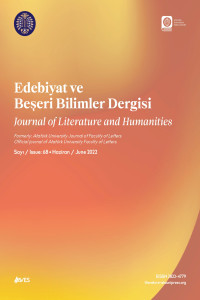Charles Dickens’ın Çanlar Adlı Eserinde Doğaüstü Olaylar ve Toplumsal Eleştiri
Charles Dickens, gerçekçi eserlerine doğaüstü unsurlar dahil eder. Bu yüzden, Viktorya döneminde süregelen, doğaüstü güçlerin varlığıyla ilgili dine ya da bilime dayalı birbirine zıt açıklamalara atıfta bulunur. Ancak Dickens, Çanlar adlı hayalet hikayesinde, doğaüstü olaylarla ilgili geleneksel görüşlerden çok bilimsel yaklaşımlara odaklanır. Genellikle ana karakterin zihnini ve tekinsiz imgelemleri yoksul vatandaşları sarsan toplumsal problemlere ve eşitsizliğe bağlar. Bu çalışma, belirtilen eseri doğaüstü güçlerin tasviri açısından ele almaktadır. Bilinmeyen ve esrarengiz varlıklara karşı Viktorya dönemindeki yaklaşımları kısaca irdeledikten sonra, Dickens’ın bu unsurları toplumsal eleştiriyle birlikte nasıl kullandığını incelemektedir.
Anahtar Kelimeler:
Charles Dickens, toplumsal eleştiri, Zihin, Çanlar, Doğaüstü olaylar
Supernatural Elements and Social Criticism in Charles Dickens’s The Chimes
Charles Dickens incorporates supernatural elements in his realistic works. He, therefore, refers to opposite religious and scientific explanations for the existence of unearthly phenomena that prevailed in the Victorian period. However, in The Chimes, one of his ghost stories, he focuses on scientific attitudes to supernatural beings rather than conventional views. He generally relates the main character’s mind and uncanny visions to social problems and inequality which traumatize underprivileged citizens. This study examines the work in relation to the depiction of the supernatural. After a brief discussion of the Victorian attitudes to the eerie and the unknown, it discusses the ways in which Dickens employs supernatural figures, blending them with social criticism.
Keywords:
Charles Dickens, The Chimes, the supernatural, social criticism, mind,
___
- Bauer, Matthias. (2015). “The Chimes and the Rhythm of Life”. Joachim Frenk, Lena Steveker (eds.). Charles Dickens as an Agent of Change. (p. 111-27). New York: AMS Press.
- Chakraborty, Soumya. (2012). “Dark Side of the Moon: Dickens and the Supernatural”. Rupkatha Journal on Interdisciplinary Studies in Humanities, IV/1, p. 58-72.
- Dickens, Charles. (2006). “The Chimes”. Robert Douglas-Fairhurst (ed.). A Christmas Carol and Other Christmas Books. (p. 85–162). Oxford: Oxford University Press. (Originally published in 1844)
- Dickson, Melissa. (2020). “Dickens’s nightmare: dreams, memory, and trauma”. Interface Focus, 10, p. 1-8. http://dx.doi.org/10.1098/rsfs.2019.0076.
- Gordon, John. (2011). Sensation and Sublimation in Charles Dickens. New York: Palgrave Macmillan
- Harris, Jason Marc. (2008). Folklore and the Fantastic in Nineteenth-century British Fiction. Aldershot: Ashgate.
- Henson, Louise. (2004). “Investigations and fictions: Charles Dickens and ghosts”. Nicola Bown, Carolyn Burdett, Pamela Thurschwell (eds.). The Victorian Supernatural. (p. 44-63). Cambridge: Cambridge University Press.
- Kurata, Marilyn J. (1984). “Fantasy and Realism: A Defense of The Chimes”. Dickens Studies Annual, 13, p. 19-34.
- Moran, Maureen. (2006). Victorian Literature and Culture. London: Continuum.
- Noakes, Richard. (2004). “Spiritualism, Science, and the Supernatural in mid-Victorian Britain”. Nicola Bown, Carolyn Burdett, Pamela Thurschwell (eds.). The Victorian Supernatural. (p. 23-43). Cambridge: Cambridge University Press.
- Oppenheim, Janet. (1985). The Other World: Spiritualism and Psychical Research in England, 1850-1914. Cambridge: Cambridge University Press.
- Purchase, Sean. (2006). Key Concepts in Victorian Literature. Hampshire: Palgave Macmillan.
- Pykett, Lyn. (2001). “Sensation and the fantastic in the Victorian Novel”. Deirdre David (ed.). The Cambridge Companion to the Victorian Novel. (p. 192-211). Cambridge: Cambridge University Press.
- Slater, Michael. (1966). “Dickens (and Forster) at Work on The Chimes”. Dickens Studies, 2/3, p. 106-140.
- Smajić, Srdjan. (2010). Ghost-Seers, Detectives, and Spiritualists: Theories of Vision in Victorian Literature and Science. Cambridge: Cambridge University Press.
- Smith, Andrew. (2005). “Dickens’ Ghosts: Invisible Economies and Christmas”. Victorian Review, 31/2, p. 36-55, https://doi.org/10.1353/vcr.2005.0021.
- Tytler, Graeme. (1997). “Charles Dickens’s ‘the Signalman’: A Case of Partial Insanity?” History of Psychiatry 8/3, p. 421-32.
- Yayın Aralığı: Yılda 2 Sayı
- Başlangıç: 1970
- Yayıncı: Atatürk Üniversitesi
Sayıdaki Diğer Makaleler
EVİN SAHİBİ HİKÂYESİNDE ÜRPERTİCİ GOTİĞİN FISILTILARI
ALTIN ORDA DEVLETİ’NDE BİR DÖNÜM NOKTASI: EMİR NOGAY
Osmanlı Devleti’nin Kuruluş Devrinde (1284-1396) Stratejik Bir Unsur Olarak Türk Okçuluğu
Anwendung von Greimas' Aktantenmodell auf ein Gedicht-Beispiel: Goethe Erlkönig
Modernizm Şiirinin ve Eleştirisinin Kurʼan Metnine Yaklaşimi; Adonis Bir Örnektir
RUS EDEBİYATINDA EKSPRESYONİST GENEZ
KAZAK ŞAİRİ MEŞHUR JÜSİP KÖPEYULI’NIN VELAYETİ VE KERAMETLERİ
Charles Dickens’ın Çanlar Adlı Eserinde Doğaüstü Olaylar ve Toplumsal Eleştiri
